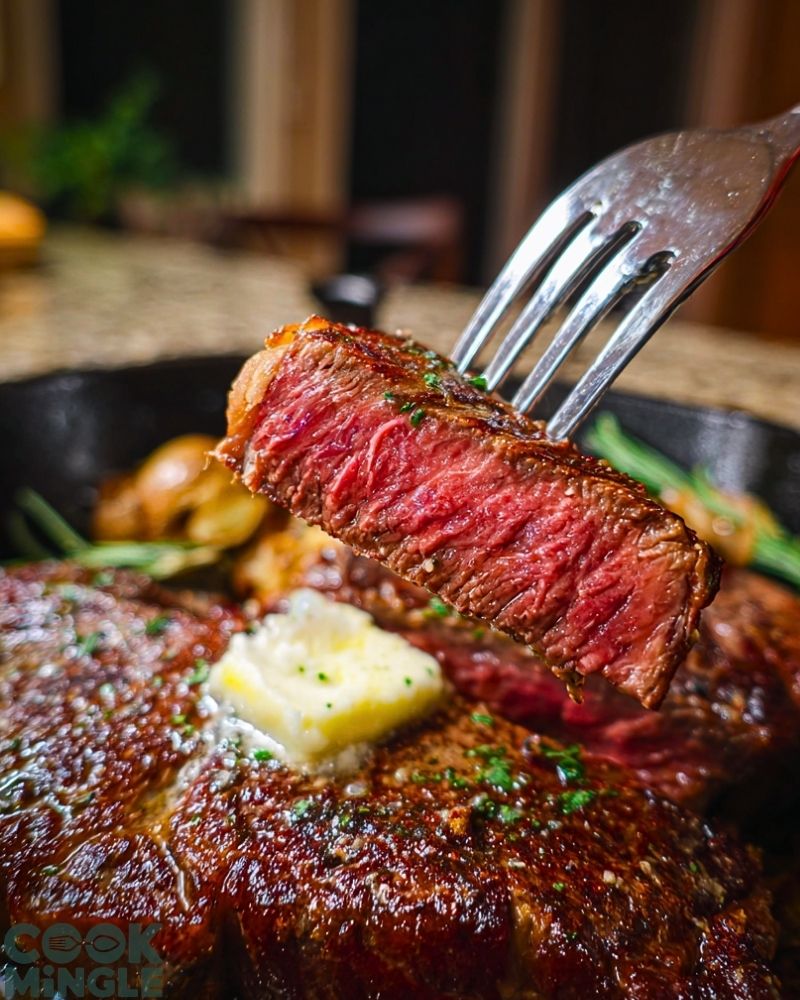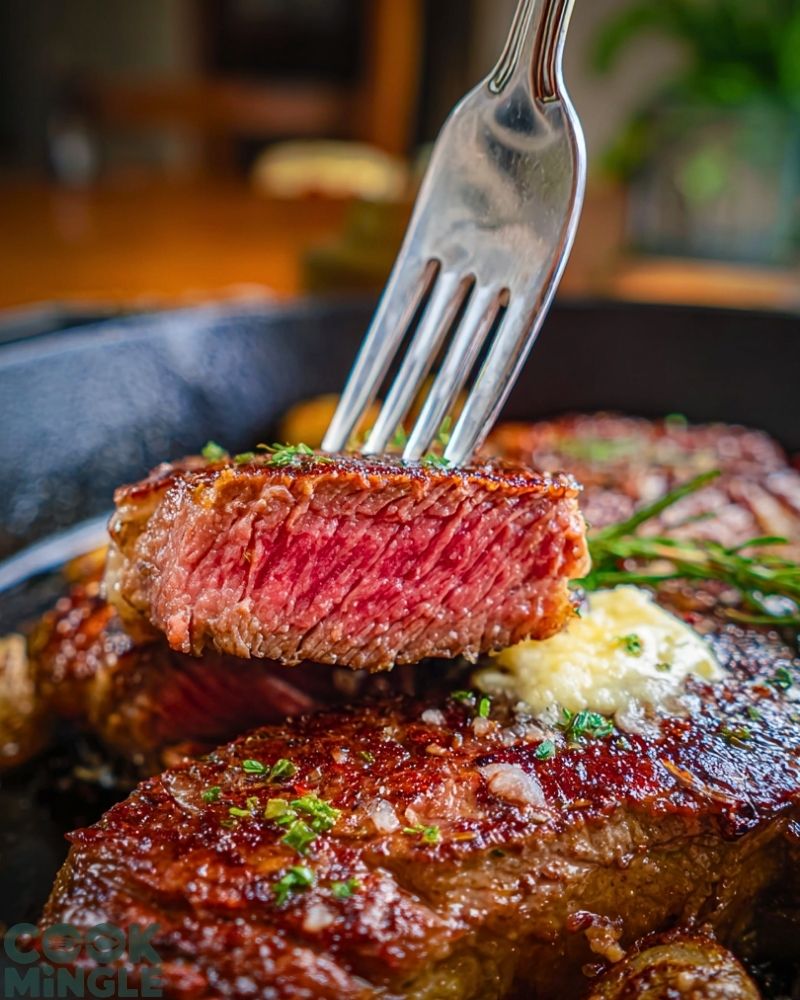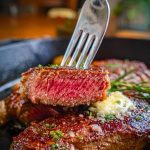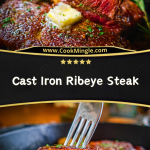Seared to perfection in a sizzling hot cast iron skillet, this ribeye steak is the definition of indulgent simplicity. With its deep caramelized crust and juicy, tender interior, each bite bursts with savory richness. The steak is finished with fragrant rosemary, charred garlic, and a pat of butter that melts into the meat, creating a glossy, buttery glaze that elevates the flavor to steakhouse quality right at home.

This dish doesn’t need complicated ingredients or fancy marinades — it relies on high heat, patience, and a few key elements to unlock the bold, meaty flavor ribeye is known for. Whether you’re preparing a romantic dinner or celebrating a special occasion, this cast iron ribeye steak is your go-to for guaranteed satisfaction.
Why You’ll Love This Cast Iron Ribeye Steak
- Unmatched Flavor: The sear from the cast iron locks in juices and creates an irresistible crust.
- Minimal Ingredients, Maximum Impact: Just salt, pepper, garlic, rosemary, and butter do the trick.
- Perfect for Any Occasion: Elegant enough for guests, easy enough for weeknights.
- Versatile Pairings: Pairs wonderfully with everything from mashed potatoes to roasted veggies.
- Foolproof Method: Once you master the timing and temperature, it’s nearly impossible to go wrong.
Preparation Phase & Tools to Use (Essential Tools and Their Importance)
Before diving into the cooking, setting yourself up with the right tools is crucial for achieving that perfect steakhouse sear and texture.
- Cast Iron Skillet: The star of the show. It retains and distributes heat evenly, creating that signature deep, crispy crust.
- Tongs: For flipping and maneuvering the steak safely without piercing the meat and losing juices.
- Meat Thermometer: Precision is key — especially when cooking to your preferred doneness.
- Paper Towels: Patting the steak dry ensures a better sear by removing surface moisture.
- Spoon: To baste the steak with butter, garlic, and herbs for enhanced flavor.
- Cutting Board (Resting Board): A safe space for resting your steak before slicing, allowing juices to redistribute.
Each of these items plays a vital role in the process, helping you replicate that steakhouse experience right in your kitchen.
Preparation Tips
- Choose a Well-Marbled Ribeye: Look for visible fat marbling, which melts into the steak for added tenderness and flavor.
- Bring Steak to Room Temperature: About 30 minutes before cooking, let the ribeye sit out — this ensures even cooking.
- Season Generously: Don’t shy away from salt and pepper. A thick steak needs bold seasoning to enhance the crust.
- Preheat the Pan Fully: Your cast iron should be smoking hot before the steak hits it — this locks in flavor immediately.
- Rest After Cooking: Always let your steak rest for 5–10 minutes to retain its juices and reach optimal tenderness.
These small details make a huge difference in how your steak turns out — rich, juicy, and bursting with flavor.
Ingredients for This Cast Iron Ribeye Steak
To create a restaurant-quality ribeye steak at home, you only need a handful of simple, high-quality ingredients. Here’s everything you’ll need:
- 1 thick-cut ribeye steak (1 to 1.5 inches thick, about 12–16 oz)
- Kosher salt (to taste)
- Freshly ground black pepper (to taste)
- 2–3 tablespoons neutral oil (such as canola or avocado oil, for high smoke point)
- 2–3 garlic cloves (smashed, skin on)
- 2–3 sprigs fresh rosemary (or thyme)
- 2 tablespoons unsalted butter
Optional:
- Flaky sea salt (for finishing)
- Crushed red pepper flakes (for a subtle kick)
Quality matters more than quantity in this recipe — fresh herbs, real butter, and a well-marbled cut are the foundation of flavor.

Step 1: Prep the Steak
Take the ribeye out of the fridge about 30 minutes before cooking. Pat it dry thoroughly with paper towels. Generously season both sides with kosher salt and freshly cracked black pepper, pressing the seasoning into the meat.
Step 2: Heat the Skillet
Place your cast iron skillet over high heat and let it get hot — this should take about 5 minutes. It should lightly smoke when ready. Add the neutral oil and swirl to coat.
Step 3: Sear the Steak
Carefully lay the steak in the hot skillet. Let it sear undisturbed for about 3–4 minutes. Flip with tongs and sear the other side for another 3–4 minutes. Resist the urge to move it too much — this builds the crust.
Step 4: Add Flavor Boosters
Once both sides have seared, add the smashed garlic cloves, rosemary sprigs, and butter to the pan. Tilt the skillet slightly and use a spoon to baste the melted butter over the steak repeatedly for about 1–2 minutes.
Step 5: Check for Doneness
Use a meat thermometer to check internal temperature:
- Rare: 120–125°F
- Medium Rare: 130–135°F
- Medium: 140–145°F
- Medium Well: 150–155°F
Once it hits your desired temperature, remove the steak from the skillet.
Step 6: Let It Rest
Place the steak on a clean cutting board and loosely tent it with foil. Let it rest for 5–10 minutes before slicing. This step is key to juicy, flavorful meat.
Step 7: Slice & Serve
Slice against the grain and finish with a sprinkle of flaky sea salt, if desired. Spoon any remaining butter from the skillet over the top for extra richness.
Notes
- Thickness Matters: For best results, choose a ribeye that’s at least 1 inch thick. Thinner cuts may overcook before a good crust forms.
- Herb Flexibility: If rosemary isn’t your favorite, fresh thyme or even sage can offer a great aromatic boost.
- Butter Basting Tip: Keep the skillet slightly tilted to pool the butter on one side for easier basting.
- Oil Selection: Use oils with high smoke points (like avocado, grapeseed, or canola) to prevent burning.
Watch Out for These Mistakes While Cooking
- Skipping the Preheat: A cold or not-hot-enough skillet won’t give you that golden crust. Always preheat thoroughly.
- Under-seasoning: Salt and pepper are the primary flavor enhancers here. Don’t be shy.
- Overcrowding the Pan: Cook one steak at a time to avoid steaming instead of searing.
- Poking the Steak: Avoid pressing or poking with a fork. This causes juices to escape, drying out the meat.
- Neglecting Rest Time: Cutting into the steak too early causes juices to run out, leading to dryness.
- Burning the Butter: Add butter after the initial sear to prevent it from burning before basting begins.
- Using Cold Meat: If the steak is too cold, it’ll cook unevenly and may be raw in the center.
- Overcooking: Use a thermometer — guessing leads to overdone or undercooked meat.
Avoiding these pitfalls is the difference between an average steak and a flawless one.
What to Serve With Cast Iron Ribeye Steak?
A great ribeye deserves an equally great lineup of sides and accompaniments. Here are eight top-tier recommendations that complement the steak’s rich, savory profile:
8 Recommendations
- Garlic Mashed Potatoes – Creamy and buttery with just enough garlic to stand up to the bold steak.
- Roasted Brussels Sprouts – Crispy and caramelized, they add a bitter crunch that balances the richness of the meat.
- Creamed Spinach – A classic steakhouse side, silky and cheesy with just the right touch of comfort.
- Grilled Asparagus with Lemon Zest – Fresh and slightly smoky with a burst of citrus to lighten the plate.
- Truffle Fries or Parmesan Wedges – Crispy potatoes with indulgent toppings elevate any steak dinner.
- Caesar Salad – Crisp romaine, tangy dressing, and crunchy croutons bring refreshing contrast.
- Balsamic Glazed Carrots – Sweet and tangy, they offer a vibrant splash of flavor.
- Red Wine Reduction Sauce or Chimichurri – A sauce option can amplify the meat’s depth or bring a herbal zing.
Whether you’re going for elegant or rustic, these sides turn your ribeye into a complete, well-rounded meal.
Storage Instructions
If you have leftovers, proper storage ensures the steak stays flavorful and safe to eat.
- Refrigeration: Let the steak cool completely, then place in an airtight container. Store in the refrigerator for up to 3–4 days.
- Freezing: Wrap tightly in plastic wrap and foil or vacuum seal. Store in the freezer for up to 2 months. Thaw overnight in the fridge before reheating.
- Reheating Tips: Reheat gently in a low oven (around 275°F) until warmed through, or slice and warm quickly in a skillet with a bit of butter to retain moisture.
Avoid microwaving if possible, as it can make the steak rubbery and unevenly heated.
Estimated Nutrition
Per serving (based on one 12 oz ribeye with butter):
- Calories: 780
- Protein: 50g
- Fat: 64g
- Saturated Fat: 26g
- Unsaturated Fat: 34g
- Trans Fat: 1g
- Carbohydrates: 1g
- Fiber: 0g
- Sugar: 0g
- Cholesterol: 180mg
- Sodium: 650mg
These values may vary depending on steak size and additional ingredients used, but this provides a solid baseline for most preparations.
Frequently Asked Questions
1. Can I cook the ribeye straight from the fridge?
It’s not recommended. A cold steak won’t cook evenly and may result in an undercooked center. Let it sit at room temperature for 30 minutes before cooking.
2. What’s the best cut for this recipe if I don’t have ribeye?
Strip steak or New York strip is a great alternative. It’s also flavorful and cooks well in a cast iron skillet.
3. How do I know when the cast iron skillet is hot enough?
The pan should be slightly smoking. A drop of water should instantly sizzle and evaporate when splashed in the pan.
4. Is butter necessary, or can I skip it?
Butter adds richness and flavor, especially during the basting step. If avoiding dairy, use ghee or skip basting altogether.
5. Can I use a nonstick skillet instead?
No — nonstick pans don’t handle high heat well and won’t give the same crust. Stick to cast iron or stainless steel.
6. What’s the best oil to sear a steak?
Use oils with high smoke points like canola, avocado, grapeseed, or sunflower oil.
7. How do I avoid overcooking the steak?
Use a meat thermometer and monitor the internal temperature closely. Pull it from the pan a few degrees before it hits your target doneness.
8. Why let the steak rest before slicing?
Resting allows the juices to redistribute throughout the meat, ensuring a moist and tender bite every time.
Conclusion
Cooking a Cast Iron Ribeye Steak isn’t just about making dinner — it’s about crafting an experience. With a few quality ingredients and attention to timing and temperature, you’ll turn a simple cut of meat into something exceptional. Whether it’s for a weekday treat or a special evening, this method delivers a rich, satisfying steakhouse-style meal from the comfort of your kitchen.

Cast Iron Ribeye Steak
- Total Time: 15
- Yield: 1-2 servings
Description
Seared in a blazing hot cast iron skillet, this ribeye steak is a carnivore’s dream: rich, juicy, and crowned with a buttery garlic herb glaze. With a deeply caramelized crust and succulent interior, it’s the ultimate steakhouse experience at home.
Ingredients
1 ribeye steak (12–16 oz, 1 to 1.5 inches thick)
To taste kosher salt
To taste freshly ground black pepper
2 to 3 tablespoons neutral oil (canola or avocado)
2 to 3 garlic cloves (smashed, skin on)
2 to 3 sprigs fresh rosemary
2 tablespoons unsalted butter
Optional: flaky sea salt, crushed red pepper flakes
Instructions
1. Take the steak out of the fridge and let it rest for 30 minutes to reach room temperature.
2. Pat the steak dry with paper towels. Season generously with salt and black pepper.
3. Preheat your cast iron skillet over high heat for 5 minutes until slightly smoking. Add the oil.
4. Carefully place the steak in the skillet. Sear for 3–4 minutes on the first side without moving.
5. Flip and sear the other side for another 3–4 minutes.
6. Add garlic, rosemary, and butter to the skillet. Tilt the pan and baste the steak with butter for 1–2 minutes.
7. Check internal temperature using a meat thermometer. Remove at your preferred doneness.
8. Let the steak rest on a cutting board for 5–10 minutes.
9. Slice against the grain. Optionally, sprinkle with flaky sea salt and drizzle remaining butter from the pan.
- Prep Time: 5
- Cook Time: 10
- Category: Main Course
- Method: Searing
- Cuisine: American
Nutrition
- Serving Size: 12 oz
- Calories: 780
- Sugar: 0g
- Sodium: 650mg
- Fat: 64g
- Saturated Fat: 26g
- Unsaturated Fat: 34g
- Trans Fat: 1g
- Carbohydrates: 1g
- Fiber: 0g
- Protein: 50g
- Cholesterol: 180mg

